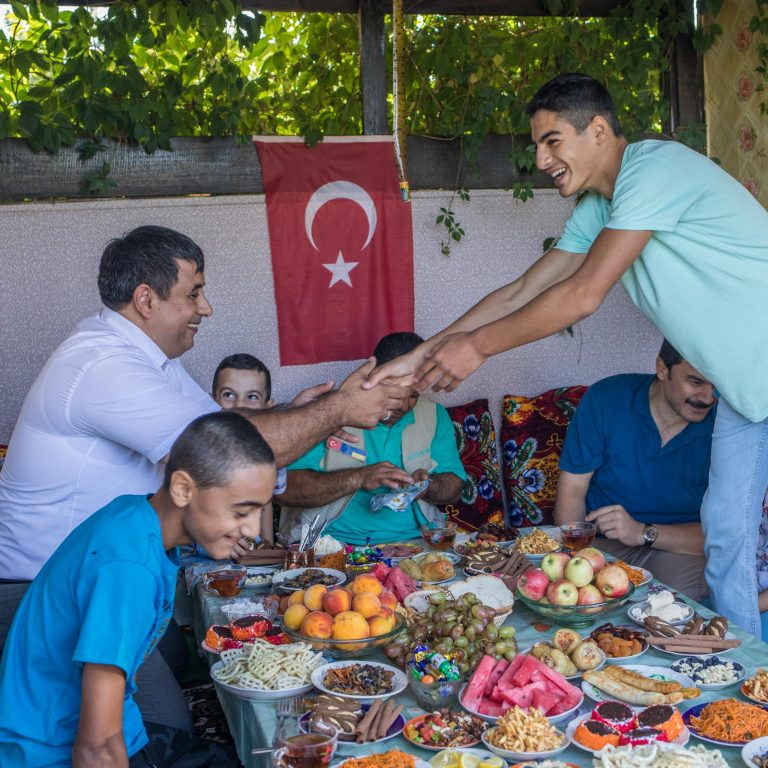Meskhetian Turks are Turkic speaking people that follow Islam and originate, allegedly, from the territory of historic Meskhetia (Georgia). The Meskhetian Turks community resides in Ukraine since the 1990s. They had to re-settle two times: at first in 1944 when the Soviet authorities moved them from native lands to Central Asia, and the second time it happened in the 1990s when they fled Uzbekistan due to ethnic clashes. Ukrainian Meskhetian Turks cherish their traditions and abide religious holidays such as Eid al-Adha.
They were forced to leave their motherland in 1944 and then had to leave their homes in 1989 again. They were persecuted and falsely accused. Nowadays, their community focuses on the preservation of traditions that got wiped away during Soviet times, for instance, Qurbān Bairām.
Eid al-Adha is considered to be one of the most important holidays in Islam. It is celebrated on the 10th day of the 12th month of the Muslim calendar Dhu’l-Hijjah.
The legend says that the prophet Ibrahim had a prophetic dream. He had to sacrifice his only son Ishmael whose birth he waited for a very long time. Ishmael didn’t resist either his father’s or God’s will, just asked to make sure that his blood wouldn’t stain the prophet’s gown and his mother wouldn’t witness the deed. Ibrahim and his son came to the valley Mina and began preparations for the offering. When the prophet brought the knife to his son’s throat he couldn’t do any harm to him. Allah had mercy on them because they demonstrated utter humbleness and loyalty. He sent a ram from paradise and it got immolated.
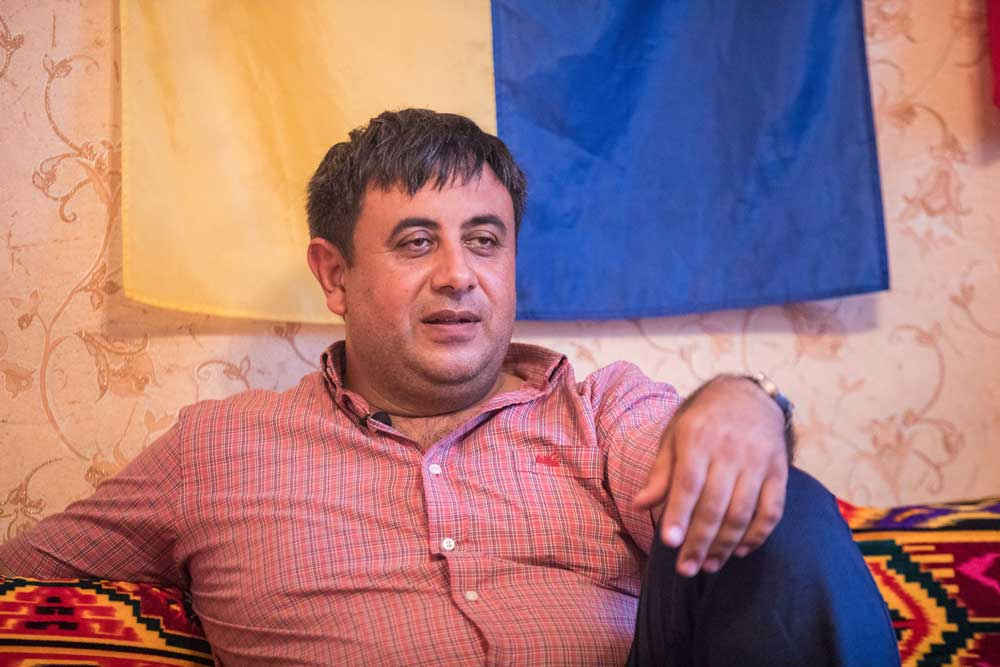
Marat Rasulov, the co-founder and head of the civil organization “All-Ukrainian society of Meskhetian Turks “Vatan”, is the main event planner of Eid al-Adha celebration. He manages the preparations of the celebration for a couple of successive years for the Ukrainian community of Meskhetian Turks.
Violent attacks on Turks broke out in Uzbekistan in 1989. After tragic events in the Fergana Valley, Marat, a teenager back then, and his parents moved to Ukraine in 1990, to the village Vynohradivka in Prychornomoria. Marat had to finish school after they moved to Vynohradivka:
— After Fergana events, people started re-settling to Russia and Ukraine. The relocation destinations were picked based on previous locations of army units where men served earlier (all young men had to serve in the soviet army and they could be sent anywhere within 15 republics), or places where some friends or acquaintances resided, places with available accommodations and work.
The houses in Vynohradivka were initially built for re-settlers from Chornobyl, however, they never moved in. For a couple of years, the houses stood empty and so they had only roofs and walls, windows and doors were missing.
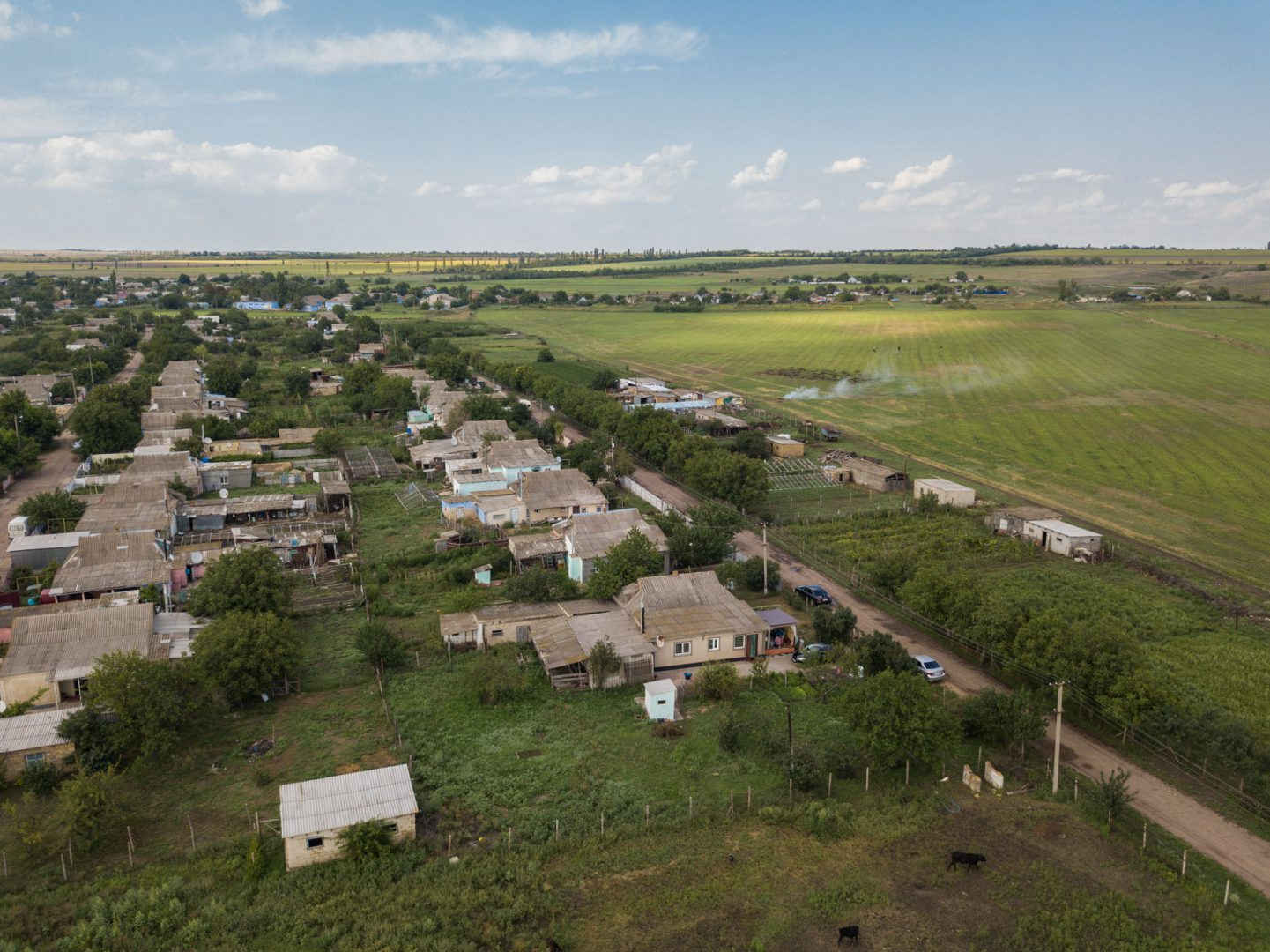
Earlier Vynohradivka had a collective farm that specialized in growing grapes. The village name derived from the word “vynohrad” that means “grape” in Ukrainian. After re-settling, the Turks started working in the gardens and gradually made the repairs, put windows in, laid floors and moved into empty houses.
Marat’s family moved to Vynohradivka on the 21st of March, 1990, and they settled in their house later in August. Till then they had lived in a dormitory.
Today, Marat and his family live in Kyiv due to his work, but he traditionally comes to Vynohradivka where his children spend every summer.
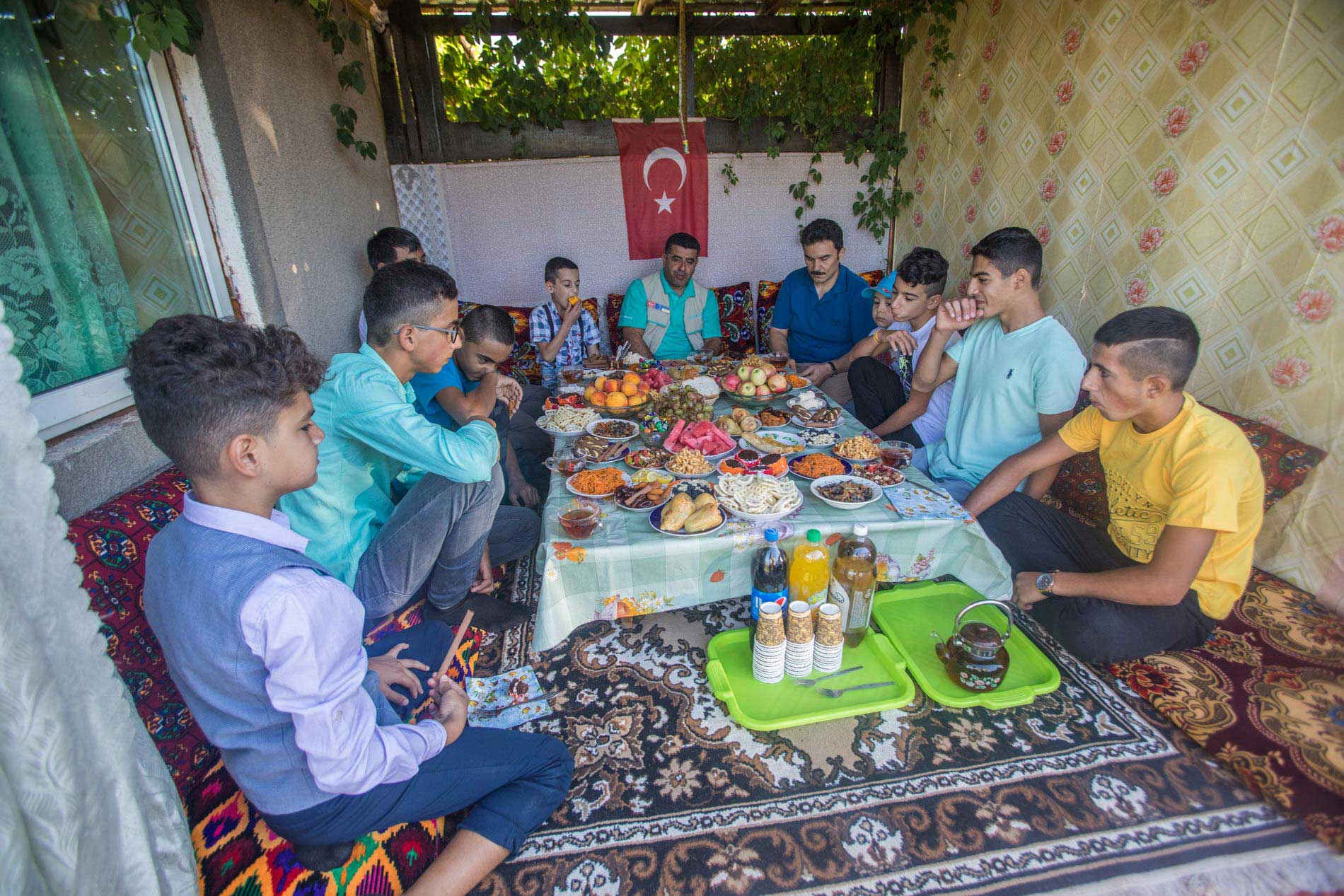
Marat Rasulov together with the World society of Turks “Ahıska Türkleri” (Meskhetian Turks — author.) organize Eid al-Adha in Vynohradivka and surrounding villages Rodnyky, Dobra Krynytsia and Kostychi. Marat explains the essence of this celebration the following way:
— Eid al-Adha is the “Festival of Sacrifice”, it is also called Qurbān Bairām where “qurbān” means “to share”. The meat of the sacrificed animal is divided into three parts: one is given to those in need, the second one goes to close people, relatives and friends, and the third part stays in the family.
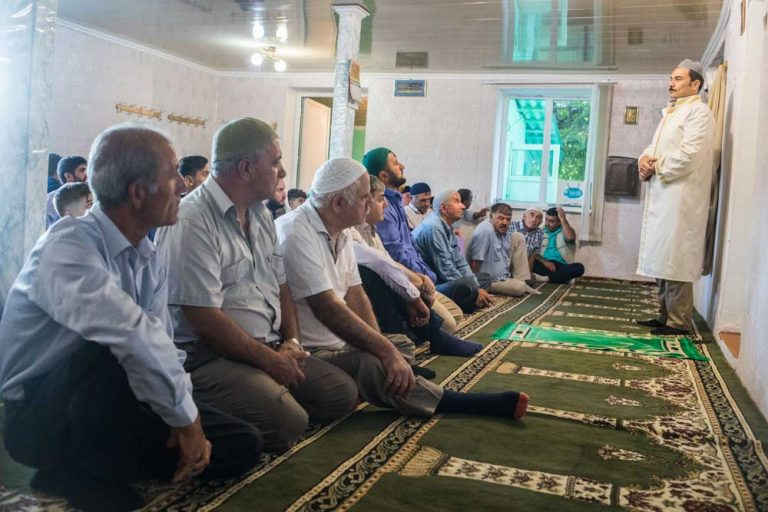
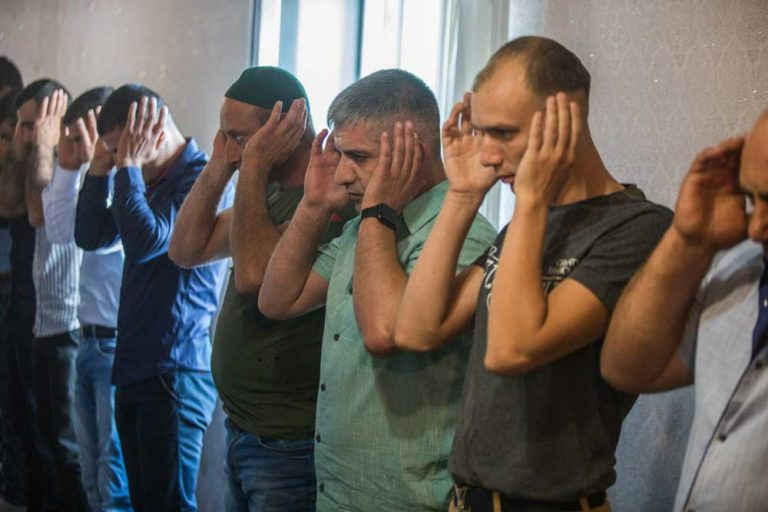
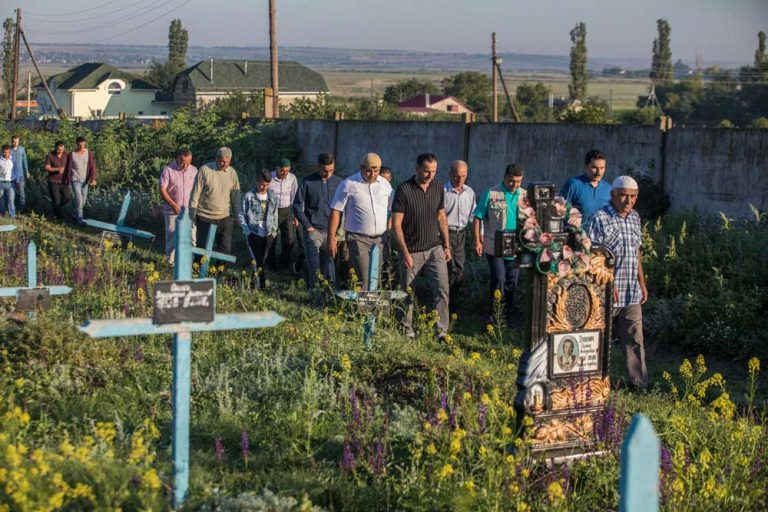
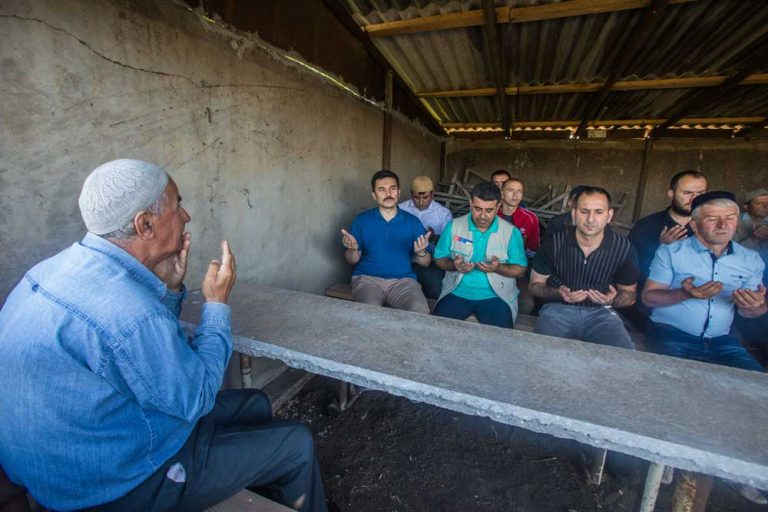
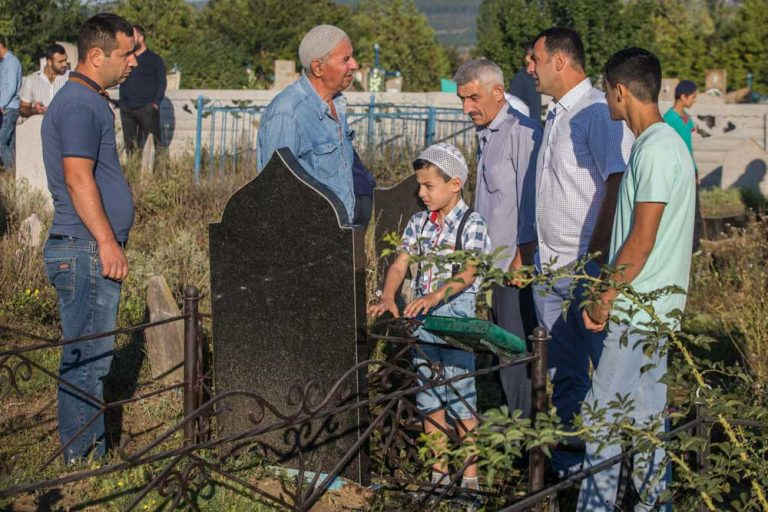
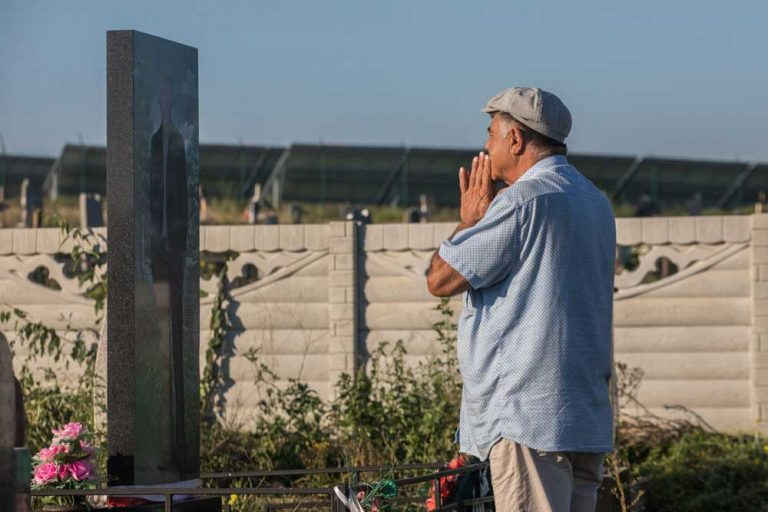
slideshow
It is unacceptable if you neighbour has no meat on this day. That is why we will have a giveaway of packaged meat so that everyone could celebrate, both those who can make a sacrifice and those who don’t.
The celebration lasts four days. On the first day, the traditional Eid prayer takes place. After that everyone goes to the cemetery to commemorate the deceased, to pray and read the Koran. In meanwhile women prepare a festive meal at home. During the following three days everyone can make meat offerings and visit relatives and friends:
— Sure enough, God does not need either meat or animal skin, he expects worship and humbleness. That’s the essence. We subdue by demonstrating to him that we fulfil his postulates.
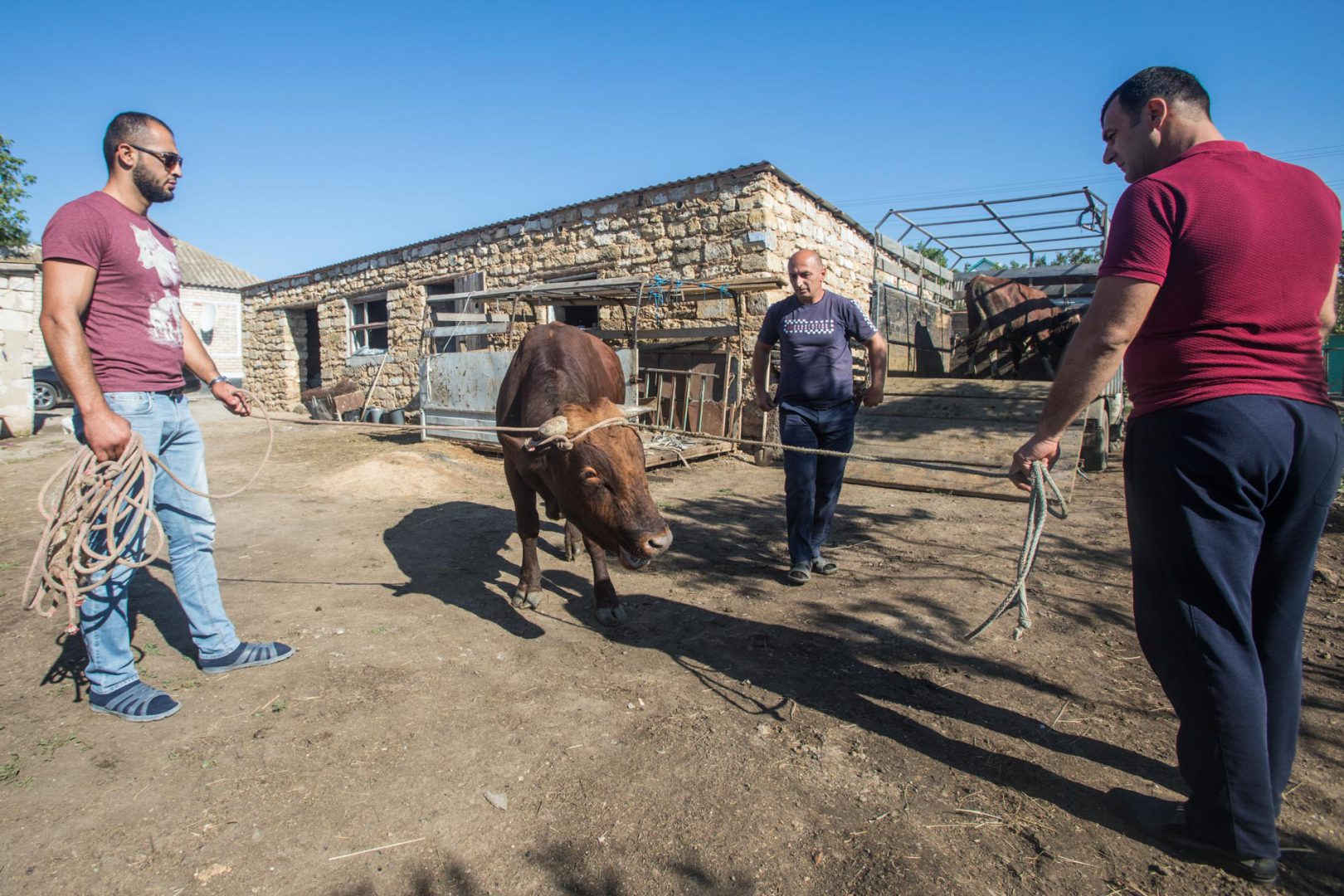
According to Sharia law, one can sacrifice a sheep, goat or bull. If the large kettle is picked for the sacrifice up to seven men can participate in the rite but the number of people involved should always be odd:
— Apart from Qurbān Bairām, the same rite takes place during Ramadan celebration. It is called “kumaniye”. Bags of food with rice, butter and sugar are given to the needy people. During Qurbān Bairām we give away meat not just to the Muslims but to our neighbours Ukrainians. We have a boarding school in our region so they get a portion of meat as well as the assisted living home.
During the day, a festive table is set in every home of Meskhetian Turks. This area is called “sakyu” with a short round tray-like table at which you sit cross-legged.
Sharia law
Norms and principles that any Muslim person should follow and that are allocated in Koran.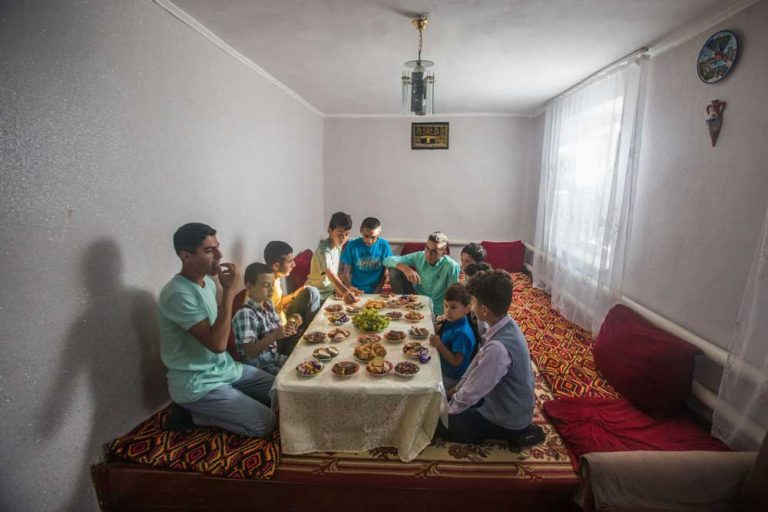
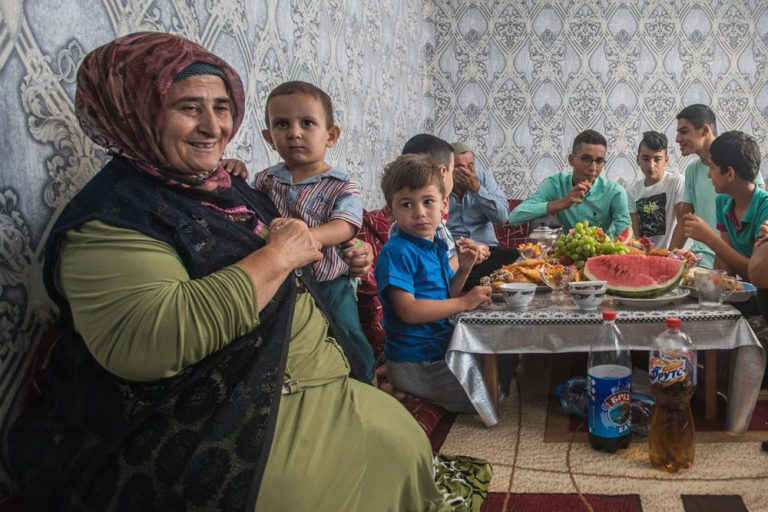
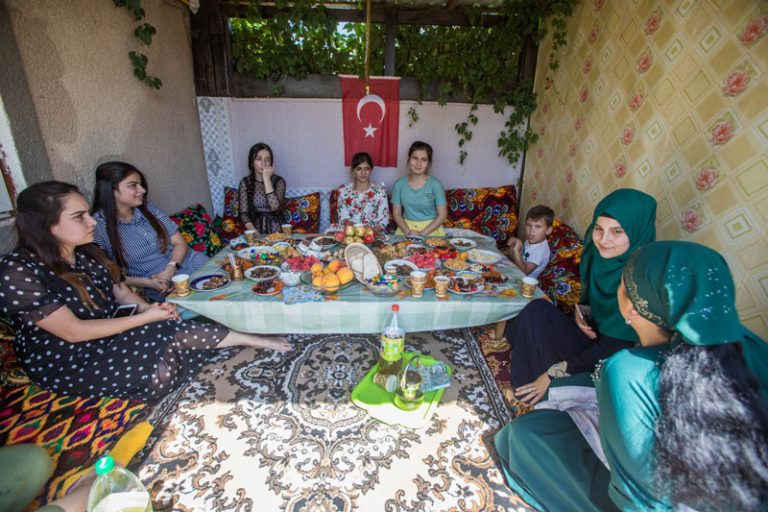
slideshow
All day long children will come to pay a visit, at first boys will come and then girls:
— You have to pay a visit to everyone. When children come they take from the table some treats in order not to offend the hosts. When you visit someone you have to share a meal in their home otherwise it is awkward. At least you should have a cup of tea.
On these days the young people must visit the elderly members of the community. Many people go to nearby villages to visit parents, grandparents and other relatives to congratulate them with the holiday in person.
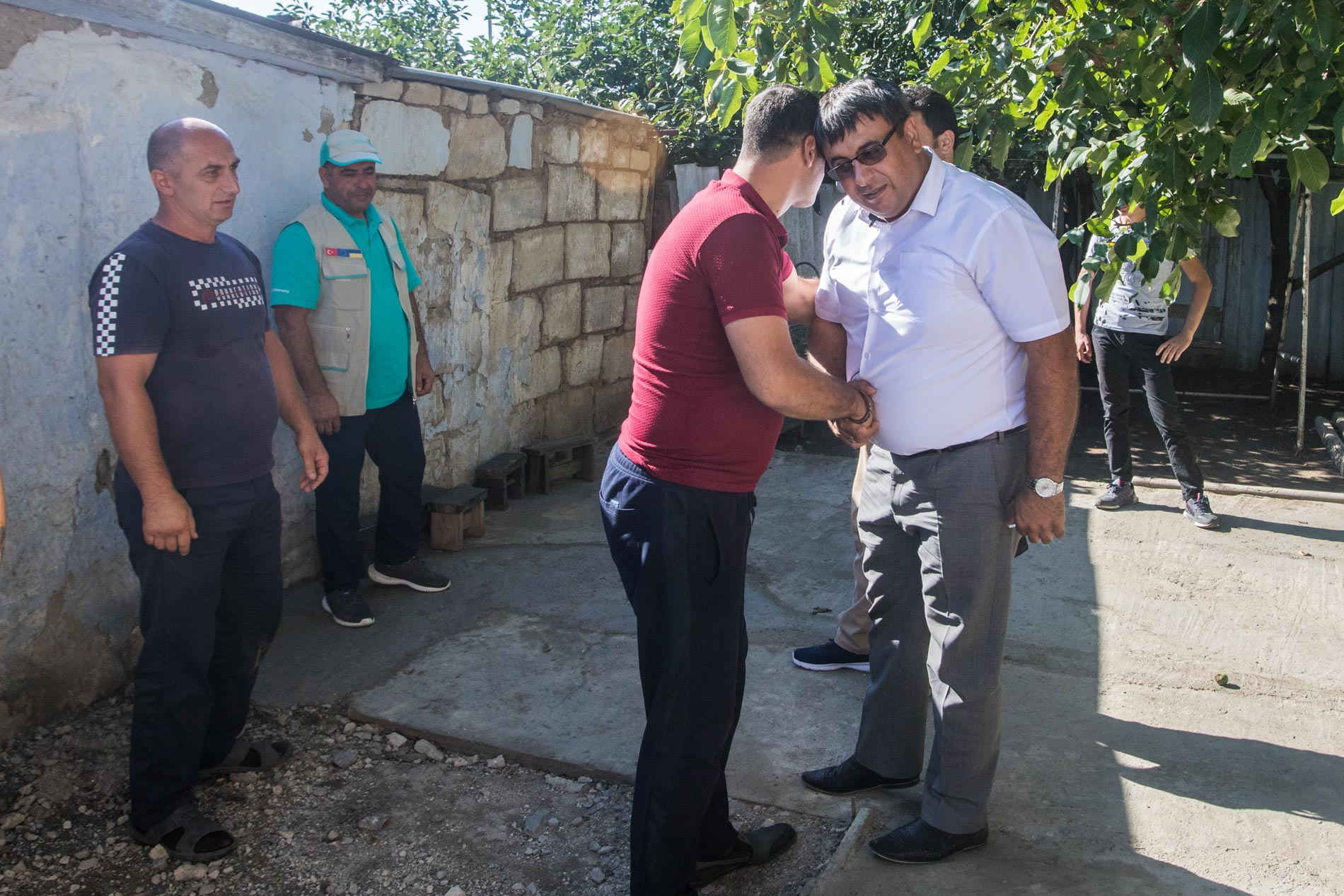
During Qurbān Bairām local Meskhetian Turks usually greet each other: Kurban Bayraminiz kutlu olsun and then they hug one other pressing their temple to other person’s temple. According to Marat a greeting like this means the wish of health and expresses hope to greet each other during next year celebration:
— We greet each other with the holiday and wish well-being and health so that next year we will be able to celebrate again
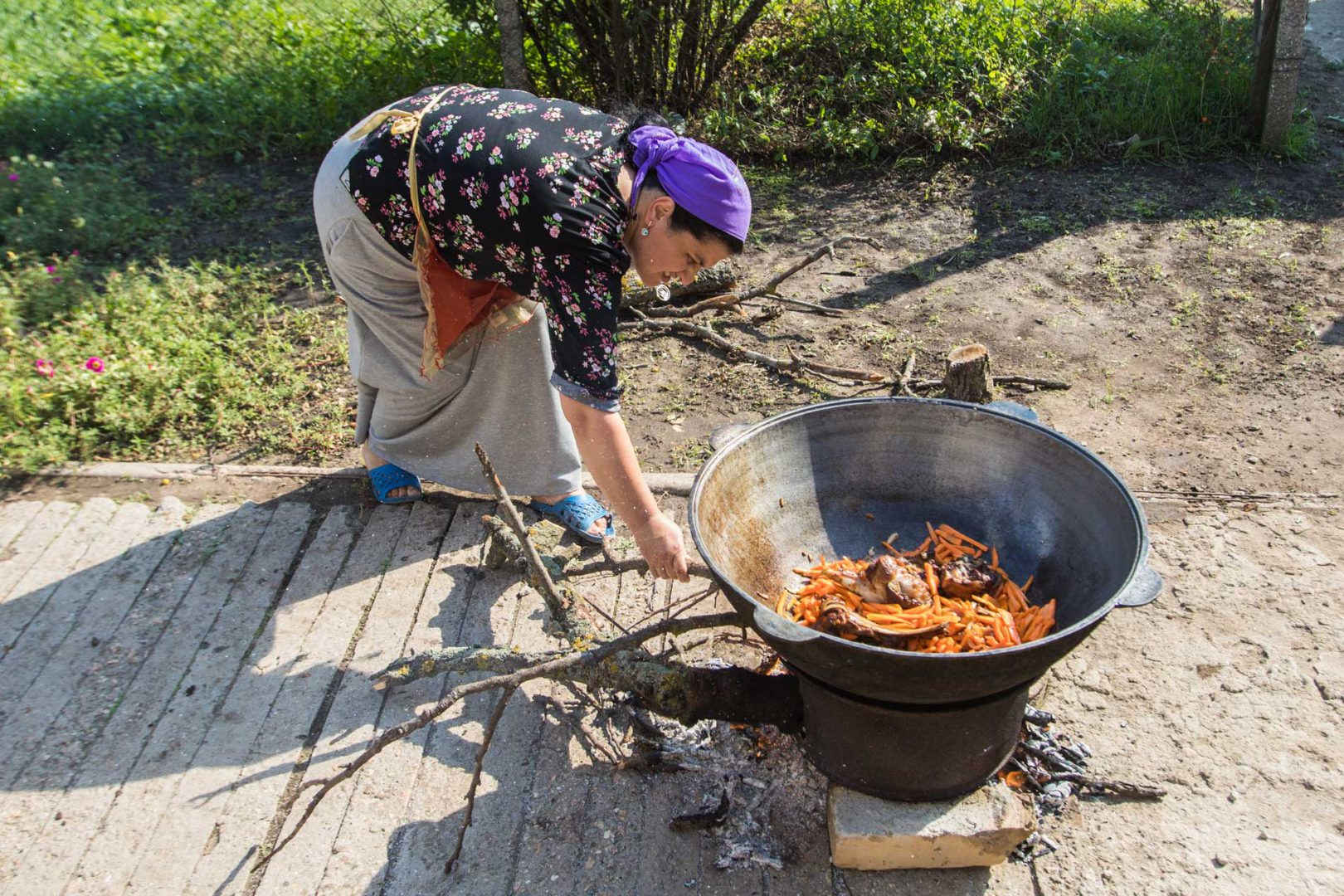
Meskhetian Turk’s cuisine has changed over the last couple of decades under the influence of Central Asian cooking since they had resided there for almost half a century. Respectively one of the traditional dishes of Eid al-Adha is Uzbek plov (a rice dish made with stock or broth, spices, and other ingredients such as vegetables and meat). It is mainly cooked by women but men can help them if needed. Firstly, mutton is fried in a caldron with onion, carrots. Next water and rice are added and all mix is stewed on slow fire:
— Traditionally women cook, but when we have big events like weddings, big celebrations then the men cook the main dish, for instance, plov, and women make salads and other meals. If we have a wedding, the whole village comes to help. For funeral reception, we make baklava (a rich, sweet dessert pastry made of layers filled with chopped nuts held together with honey).
Traditionally they also cook steamed manti dumplings, and baked stuffed buns. There are also dishes from Georgian cuisine, for example, khinkali, but Turks call them “inkal” (a boiled sack-looking dumpling with minced meat and broth inside — author.). They are smaller than Georgian equivalent.
Manti dumplings
Traditional meat dish of Central Asia, Turkey, Mongolia; the dumpling is made with minced meat wrapped in thin dough.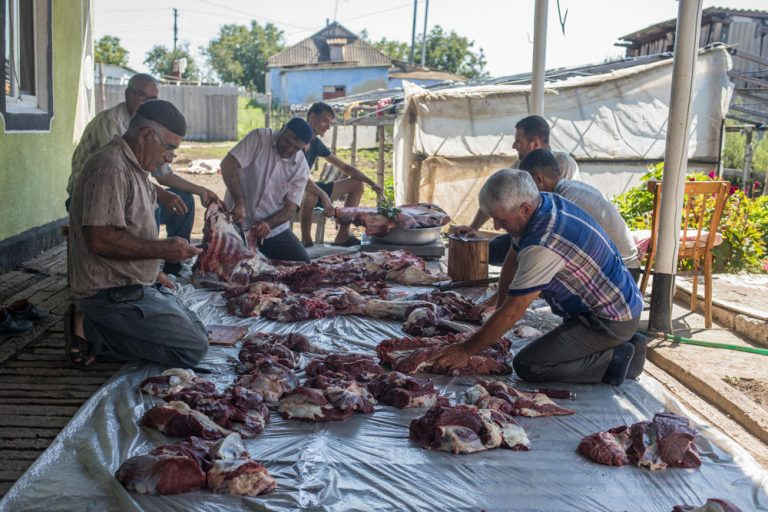
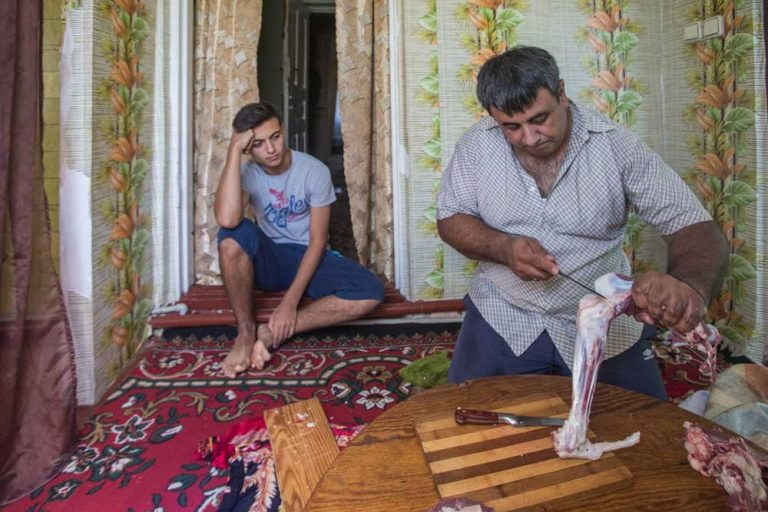
slideshow
Meat on the celebratory table is essential, it can be boiled, fried, roasted or in a form of kebab. The guests are treated with salads, traditional layered dough pastries “otmer” and sweets.
Marat recalls that in his childhood the celebration didn’t differ much from the festivities nowadays:
— Let’s say there were 73 families in Uzbekistan. But way more people took part in the celebration, that is why they used to slaughter bulls. Here our community is much smaller and people mostly slaughter rams. In childhood, I remember we went from one homestead to another where people were preparing for the holiday and they were giving us pieces of raw meat. So we collected them and then barbecued kebab outside the village in the fields.
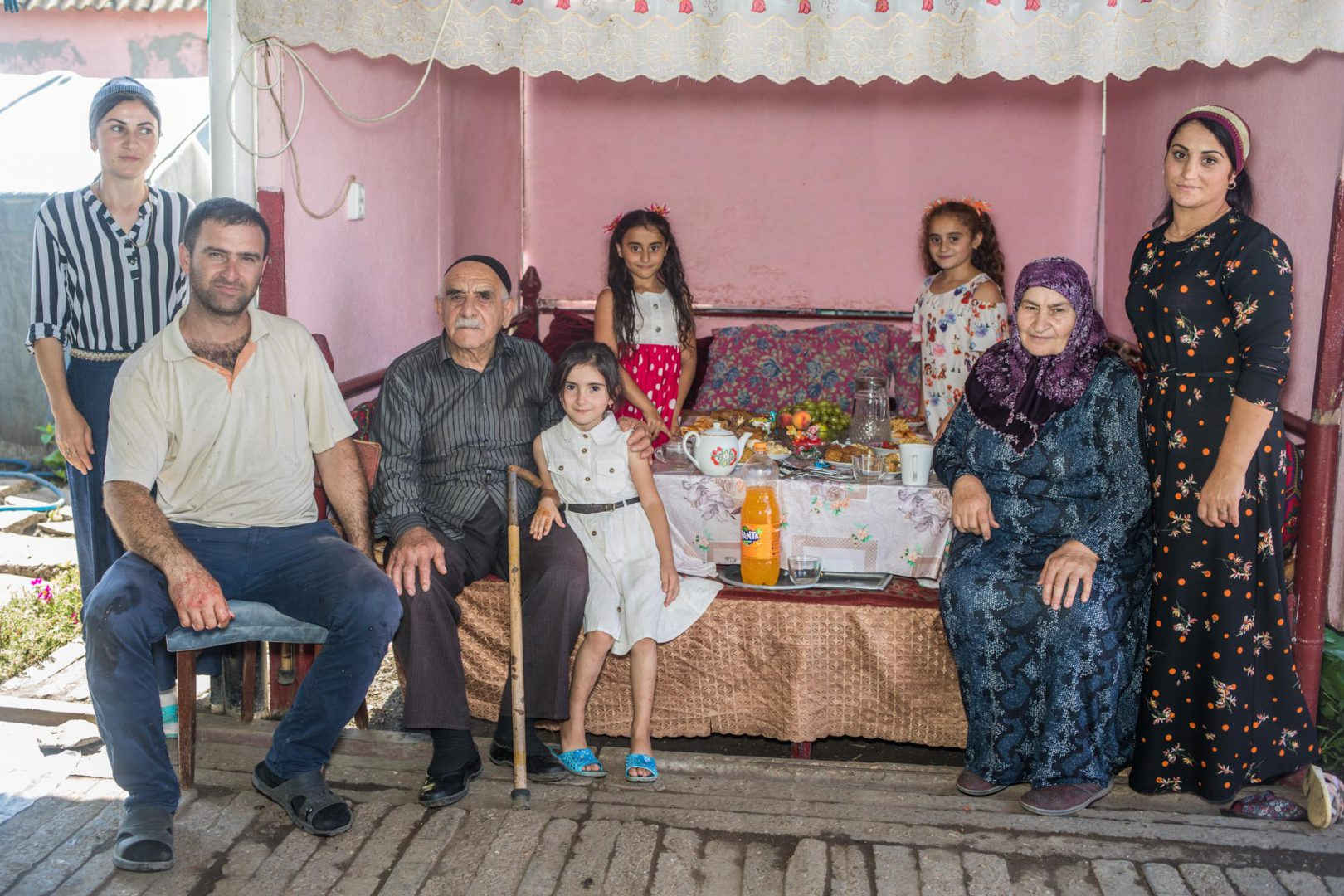
Meskhetian Turks in Ukraine
The settlement of Meskhetian Turks started appearing in large numbers on the territory of Ukraine in 1989 due to the conflicts in Uzbekistan. Meskhetian Turks are descendants of the Turks from southern and south-western regions of Georgia, Meskheti Mountain Range. They are from Akhaltsikhe, Adyghe, Aspindza regions and Javakheti.
Some researchers believe that Meskhetians descend from Georgians but due to historical circumstances converted to Islam. Other call them Turks that borrowed some ethnic features from Georgians because they lived on the border.
In November 1944 on the territory of Georgian Communist Republic, the Meskhetian ethnic group was denounced as public enemies and got deported to Central Asia with no right for relocation. The whole population of 200 villages from the South of Georgia, that equalled 155 500 people, and another 40 000 people that served at the front line (the events took place during World War II) were moved to Uzbekistan as part of Stalin’s deportation agenda.
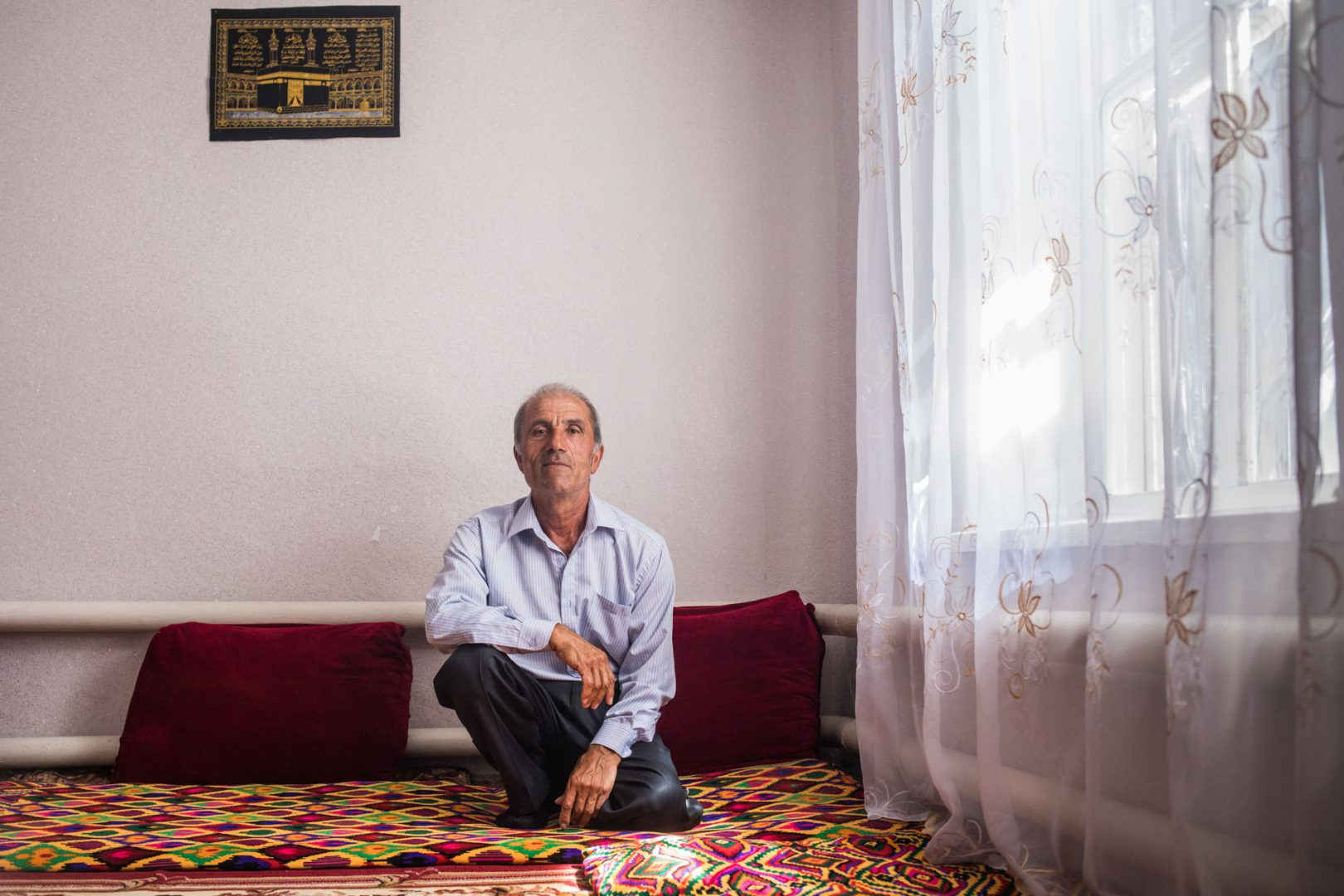
Marat’s uncle Pashali Sultanov, the co-founder and head of the civil organization “All-Ukrainian society of Meskhetian Turks “Vatan”, recalls that during his studies in university he tried to find some documents that would explain the reasons behind deportation. Only in some law newspaper from 1989, he read that the reasons for compulsory re-settlement were emigration issues, allegedly the Turks crossed the border too often.
Other official papers stated that the Meskhetian Turks were the fifth column (aided the enemy), were involved in smuggling and recruitment of agents on behalf of Turkey.
— The border was conventional. During World War II about 41 thousand Meskhetian Turks were drafted. Only 14 thousand returned. As of the 1st of January 1953, only 3,5 thousand Meskhetians remained out of 14 thousand. A lot of them died of wounds. We knew that they fought the war, but all information about this fact got classified.
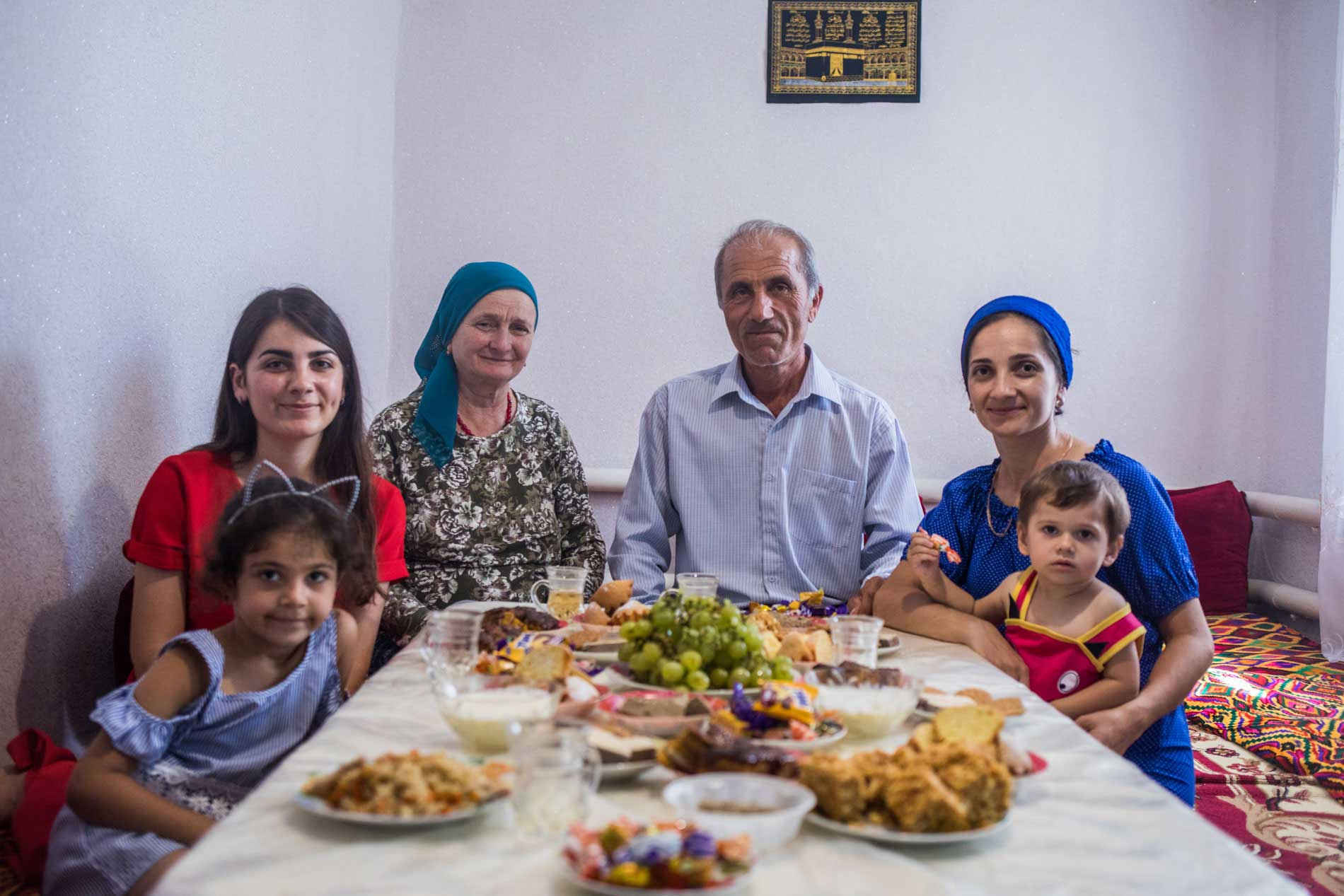
In 1989 the Meskhetian Turks had to relocate again. Cruel bashings against Turks were triggered in The Fergana Valley, Uzbekistan. Hardly anybody can explain the reasons for the ethnic clashes. There are five different versions of those events. They vary from conflict at the market, organized crime groups clashes and even political collusion.
Pashali Sultanov tells us his version of the events:
— There was some minor conflict in Fergana and people rioted, so when everything calmed down it appeared that convicts were brought by train to participate in the uprising on purpose. Local Uzbeks comprised hardly five per cent in the conflict. The majority of the participants were brought over.
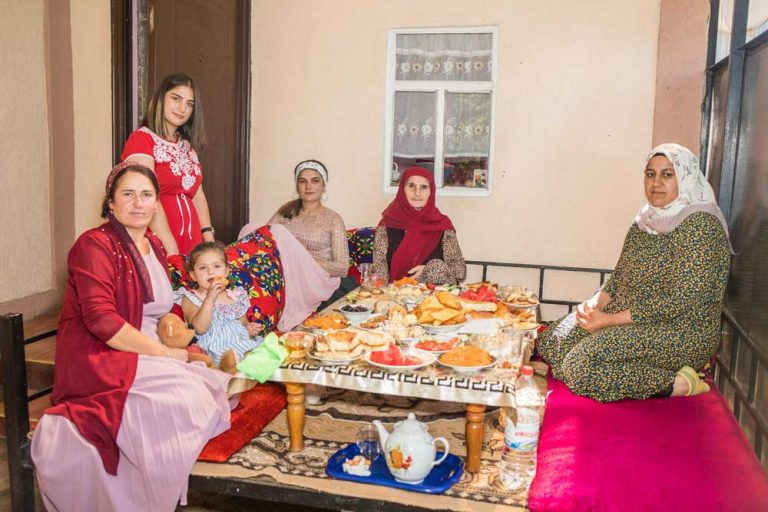
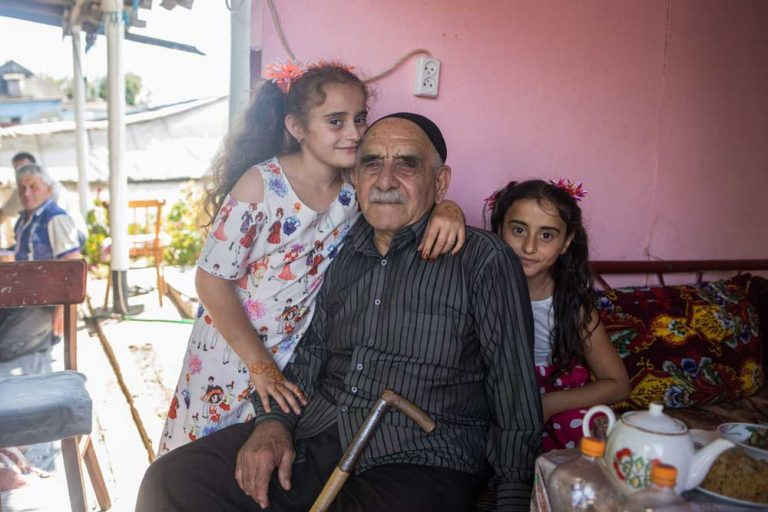
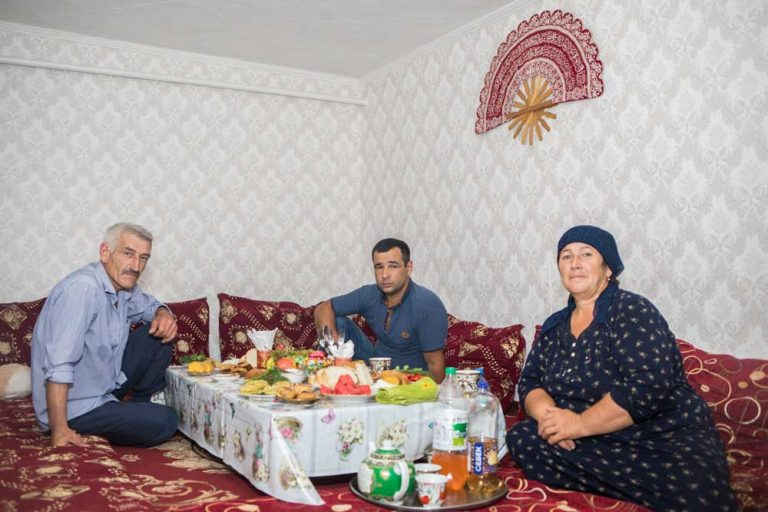
slideshow
Before the beginning of warfare (military actions) in the East of Ukraine in 2014, nearly ten thousand Meskhetian Turks resided in Ukraine. Besides Prychornomoria they settled in Zaporizhzhia, Poltavshchyna and Bessarabia.
Today, 18 families remained in Vynohradivka, and in nearby villages, there are 32 families in Rodnyky, and 64 families in Kostrych.
The families residing here are the reason for the representatives of the World Union Ahıska to visit this region. They came to organize the traditional offering ceremony and to give away meat to needy people during the Eid al-Adha. Their main goal is to revive the celebration traditions that started declining because of the soviet past.
75 years since the deportation of the Meskhetian Turks is commemorated in 2019. Marat states that the Soviet past influenced the development of the Turks community. Their mindset is different from the modern Turks since Turkey never had to deal with the Soviet legacy, unlike Georgia and Ukraine. However, the Meskhetians Turks managed to preserve some common features because they share common roots and traditions.
Pashali adds that the language has changed as well:
— I used to work with Turks, and when I speak with them I don’t understand many words. That is why I speak English with them quite often.
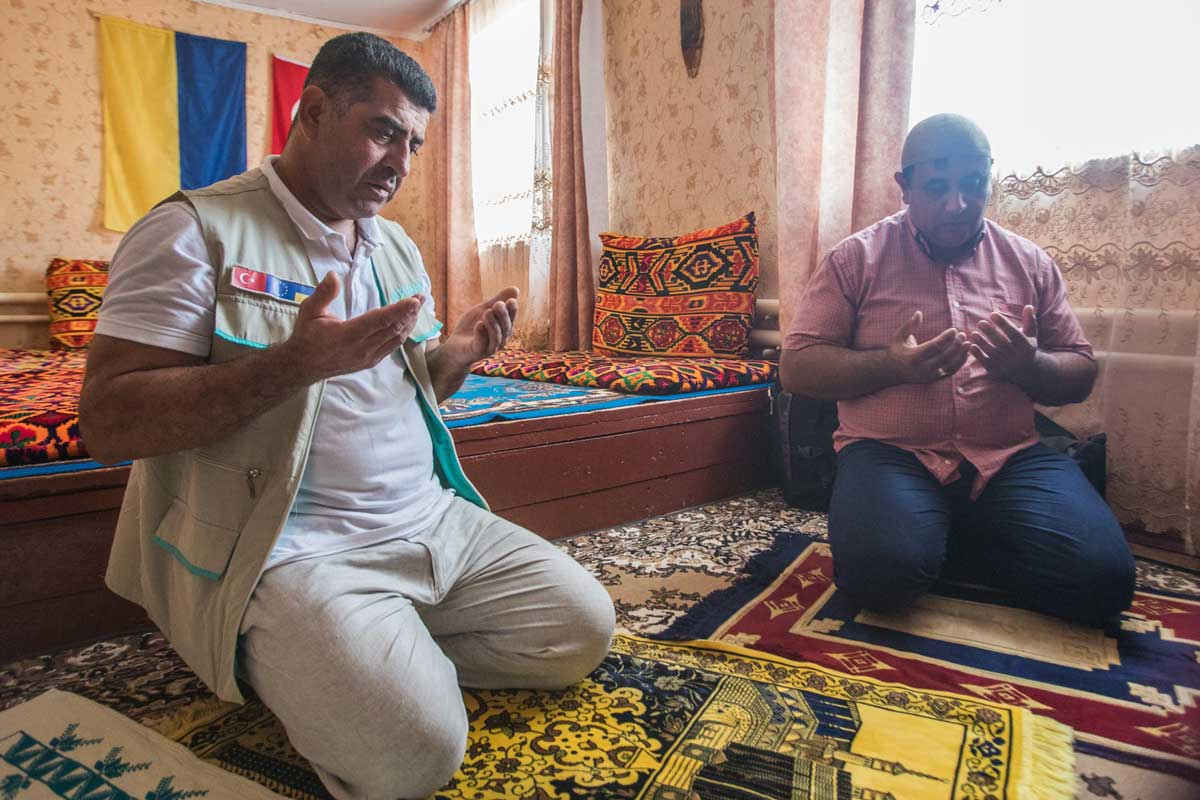
The headquarters of the organization is in Istanbul and Ukrainian branch is located in Kyiv. Marat Rasulov is the head of the organization in Ukraine. The Union assists with education in Turkey, finances sportspeople and develops Turkish communities all over Ukraine.
Each Turkish village in Prychornomoria has a mosque. There is a big number of people, that is why Qurbān Bairām celebration takes place in all communities separately. If the villages decided to get together for the festivities there would not be enough room in the mosque for everyone to observe the Eid prayers.
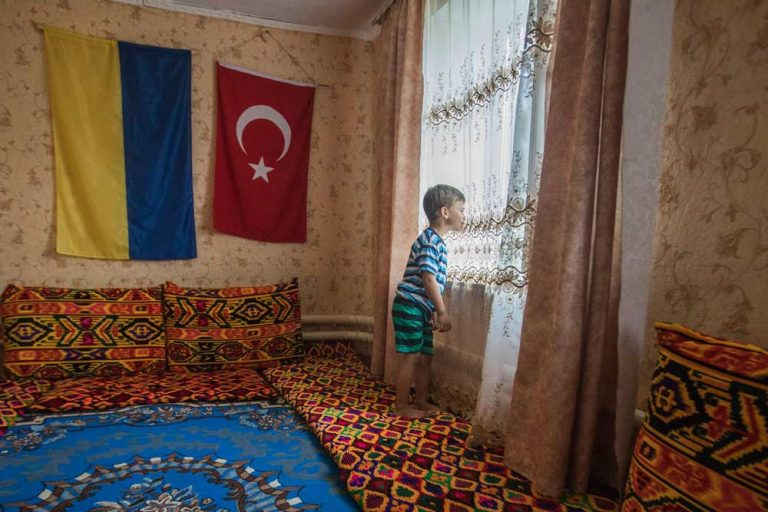
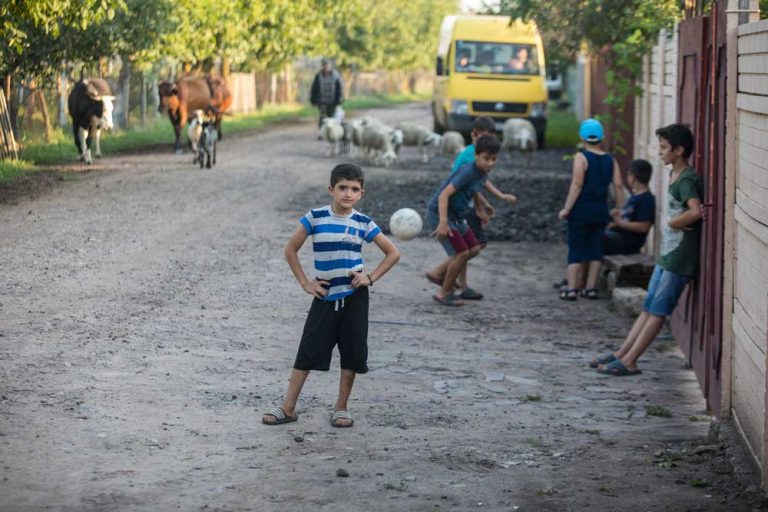
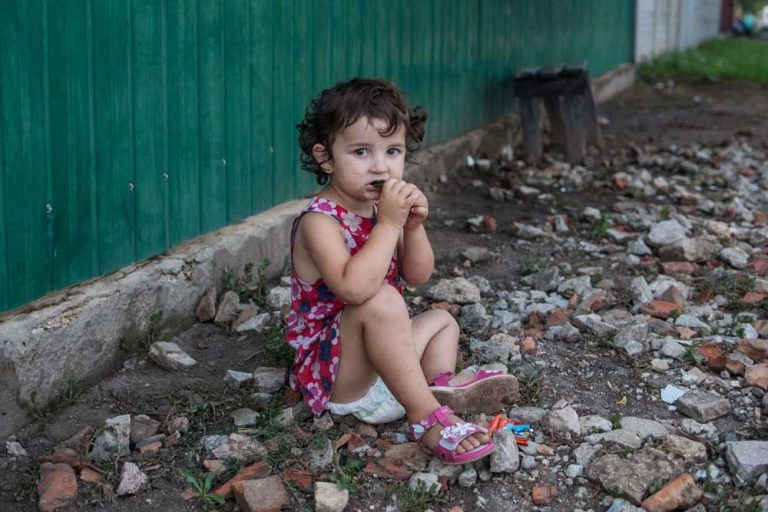
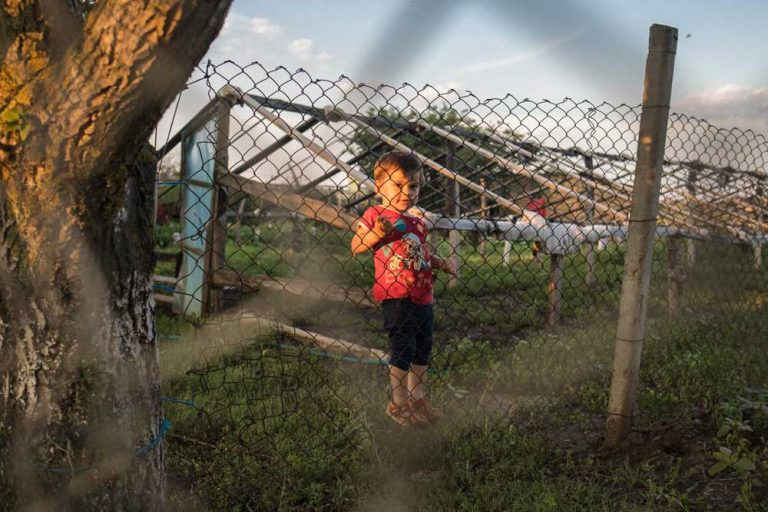
slideshow
Marat says that prayer centers and mosques open all over Ukraine. For instance, when Marat just moved to Kyiv there were just a couple of mosques in the city. Today, there is a prayer center in every district of Kyiv:
— Praise God, we have no problems in Ukraine. In other countries, Russia for instance, it is very complicated to open a prayer center, way more complicated. You need a ton of papers, permits, it is all very hard and under a lot of control.
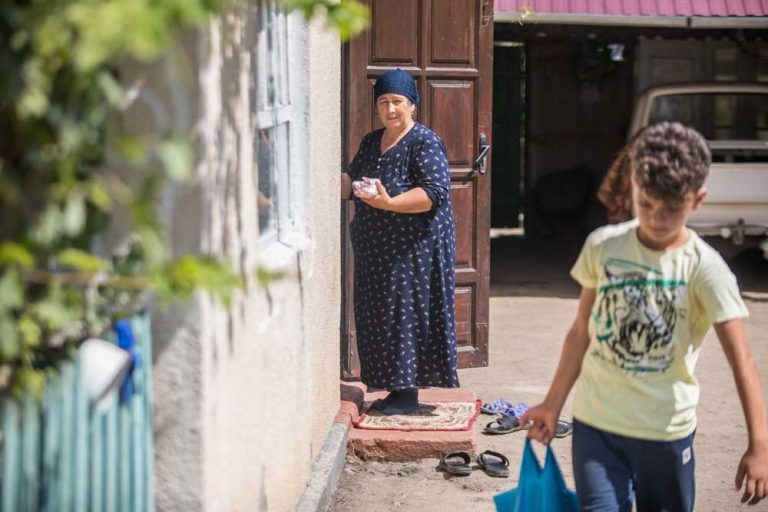
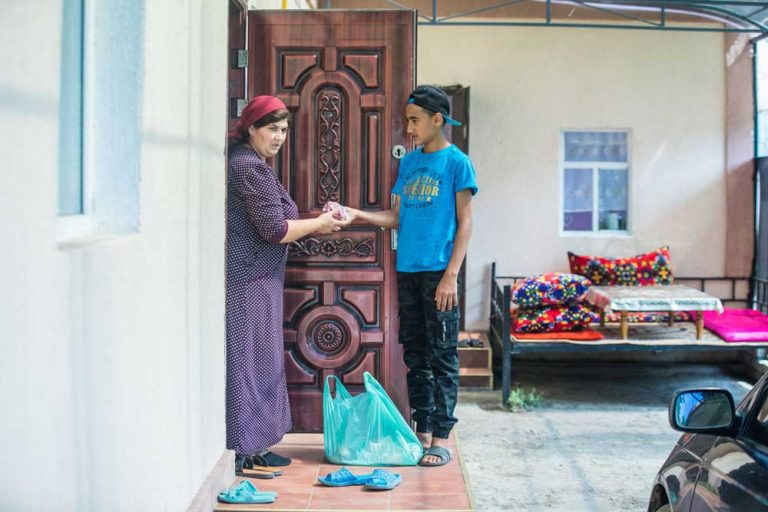
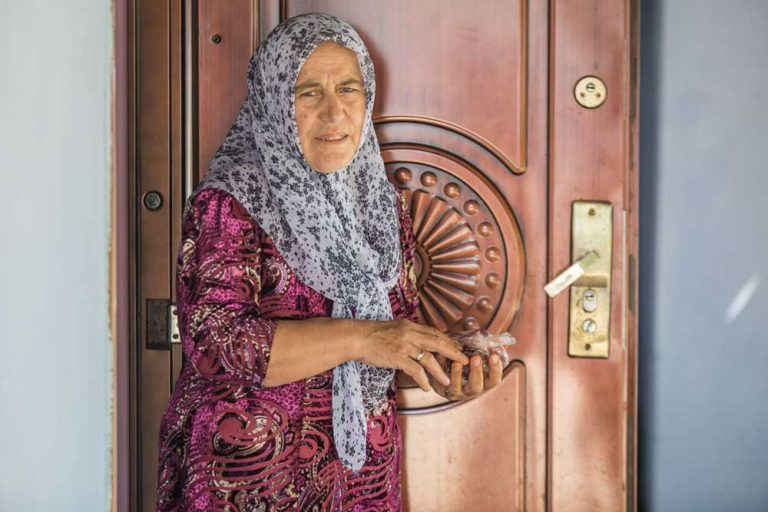
slideshow
Marat Rasulov recalls the 1990s when together with his family he moved to Kyiv and local Ukrainians helped them:
— At first, we were accommodated in the dormitory and the early days, people brought us provision: milk, cottage cheese and eggs. It was very nice that we just moved and people welcomed us like that. We will never forget it, we carry those memories along with deep gratitude.
Pashali Sultanov says that he is comfortable in Ukraine and he is not planning to move to Turkey. He is used to the lifestyle and brings up his children as patriots both of Turkey and Ukraine. According to Marat although Meskhetia is their native land, they live in Ukraine and it is their second motherland.
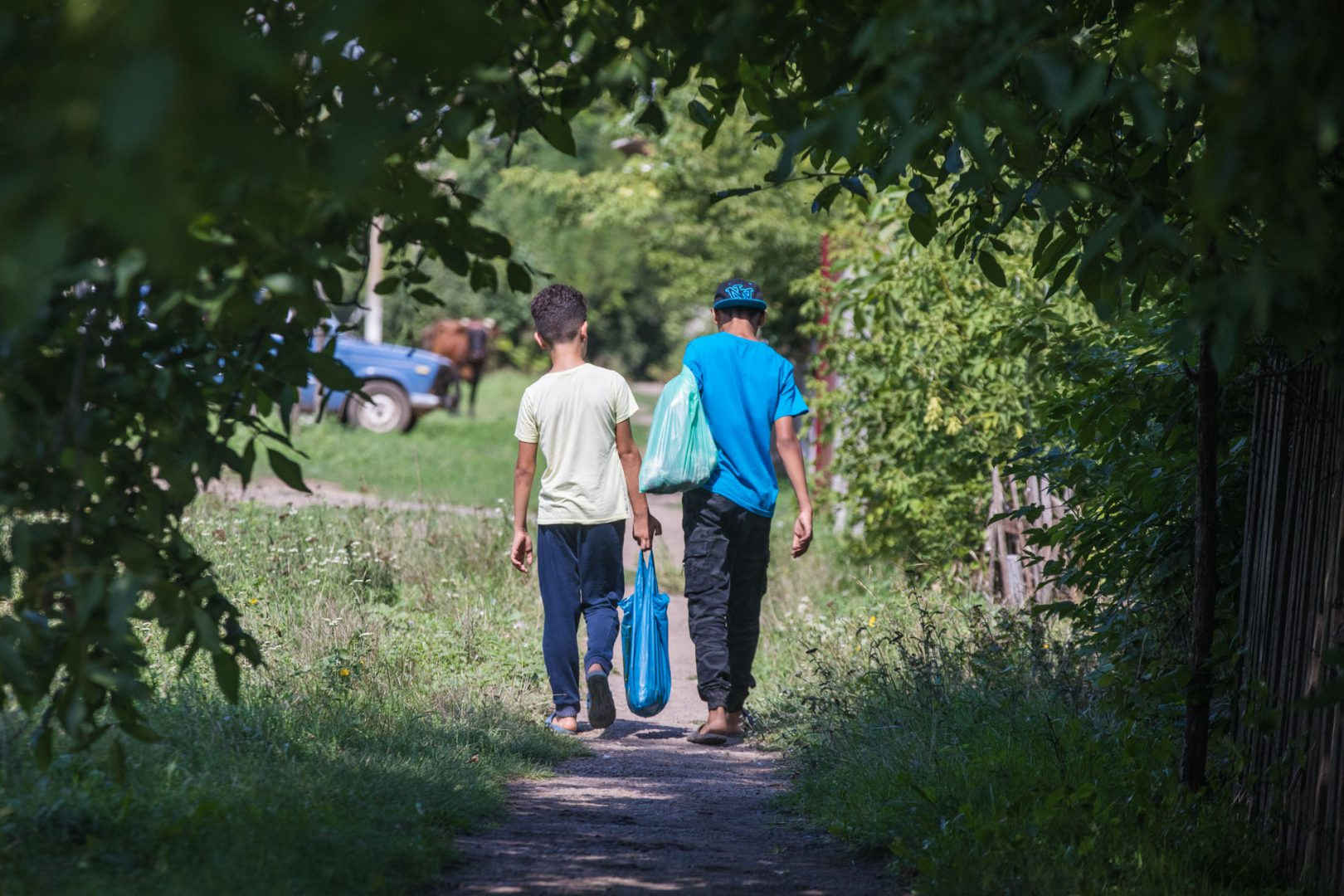
— I take with me both Ukrainian and Turkish flags wherever I go. I teach my children that this is their native land and this is their flag. So that they know, love and respect this land.

